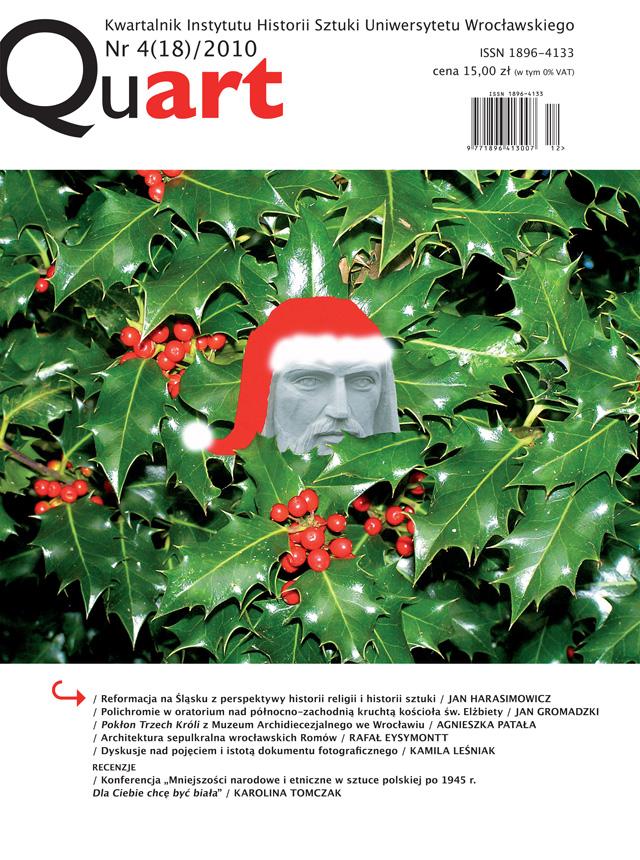Polichromie w oratorium nad północno-zachodnią kruchtą kościoła św. Elżbiety (dawna kaplica Mathiasa Smedchina)
Polychromes in the oratory above the north-west porch of St. Elizabeth's Church (former Mathias Smedchin Chapel)
Author(s): Jan GromadzkiSubject(s): Fine Arts / Performing Arts, Architecture, History of Art
Published by: Wydawnictwo Uniwersytetu Wrocławskiego
Summary/Abstract: In 2004, a few years after completion of the rebuilding of St. Elisabeth church destroyed by the fire of 1976, under a layer of plasterwork polychrome decorations from the period before Reformation were found unexpectedly in a chapel situated over north-west entrance hall (formerly called an inspector entrance (InspectorThür) or a parish hall (Pfarrhalle)), which had not been used for a century and a half. It occurred that the decorations filled the whole interior and they came out as exceptionally well preserved and, what is important, represented a remarkable level of execution. Neither tradition, nor the already known sources foreshadowed this discovery, not much was known about the very chapel. The first reference originated in 1389 and concerned a foundation for the already existing oratory, which belonged to Mathias Smedchin – dead already at the time, a member of the city council, who was most certainly the chapel‘s founder as with his name it was called still in the early 15th century. Architectural details of this two-level building indicate the second half of the 14th c. as the time of its possible errection. Later references (1404-1405) inform that Holy Trinity and Virgin Mary altar was situated in the chapel. Yet another certain notice concerning the chapel refers to placing there in 1766 a library of J. F. Burg, inspector and pastor of St. Elisabeth church. The library was placed there for the following hundred years, afterwards the chapel remained empty.The decoration covers the whole two-bay interior of the chapel, concentrating on its western and eastern walls (in its northern wall there is a huge window, and the southern wall opens in its nearly whole width and height towards the church northern aisle). It comprises three great figurative compositions that are almost as high as the wall, painted in three of four available fields on the nave walls – on the eastern wall Crucifixion and The Agony in the Garden were depicted. On the western wall, in a bay facing a window, St. Christopher was shown, whereas in a bay facing the nave four minor separate scenes were painted depicting (downwards, from left) St. Gregory the Great and Madonna Immaculata, and below The Virgin and Child with St Anne and the martyrdom of St. Mark. Single figures of saints are placed on both sides of the window (St. Benno and St. Bartholomew with splendid unidentified coats of arms) and on the wider wall beside the western side of an arcade that joins the chapel with the nave (St. Joseph). The whole interior has a frame of a red-and-brown dry branch which runs along edges of the walls and arches formed by the ceiling and closes the scenes from the bottom. Over the entrance a painted inscription describing the chapel’s dedication is placed. Polychrome decoration of the ceiling was much restored, some significant motifs are placed only on keystones – Christ’s Face is depicted in the northern bay, on the second keystone we have a red shield with a house mark that most certainly refers to one of the chapel users (it may be even the mark of its first owner). The decoration, despite the long use of the chapel in other than original function, is kept in an amazingly good condition. It is uniform and it was undoubtedly created following a specific iconographic programme which, what is important, does not show any direct relation with the patronage of the altar situated in the chapel. The two scenes, that cover nearly the whole of the eastern wall, depict basic facts from the history of Salvation, they belong to the canon of iconography related with the Eucharist and they most surely created the meaning context for the former altar. The scenes on the western wall – a huge image of St. Christopher, patron of a good death, and the other four scenes (Immaculata, St. Gregory the Great, the Martyrdom of St. Mark, the Virgin and Child with St. Anne and the connected with the latter motif St. Joseph on the southern wall) constitute cycle of de sanctis. The images of St. Benno and St. Bartholomew on the northern wall also belong to this group, however, as their monumental form and the coats of arms placed beneath them are concerned, should be considered in the context of being related to the persons of founders of the decoration, who, in view of not recognised arms, have remained unknown. The programme of the decoration focuses on church matters. Especially the presence of motifs that were controversial in regard to the Reformation developing at that time in the city (St. Benno of Meissen, the Virgin with Child and St. Anne) seems to favour the thesis that the decoration founders belonged to the clerical state – they might have been e.g. altarists serving the chapel, members of the convent of St. Mathias hospital or even members of cathedral clergy. The year of bishop Benno’s of Meissen cannonisation (1523) allows us to narrow down the time of the painting execution to the period of 1523-1525. A painter also remains anonymous, though he was distinctly talented and introduced many Renaissance elements in his traditional in numerous aspects work. The appearance of this work in St. Elisabeth church short before the conversion of the whole parish to Luther’s teachings demonstrates that the process of adopting new ideas in the city and the commune itself was not without compications.
Journal: Quart
- Issue Year: 18/2010
- Issue No: 4
- Page Range: 17-45
- Page Count: 29
- Language: Polish

